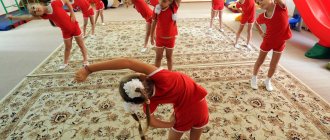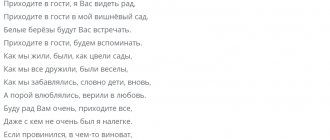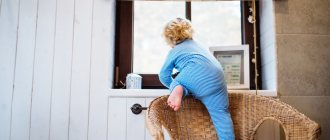Project activities
Project activity is a method of inclusion, since it is aimed at all interested children, takes into account all their characteristics and is designed to provide integrative education based on participation, cooperation and an individual approach in the distribution of responsibilities. Project activity in kindergarten is a complex joint work of teachers, children and their parents, during which children develop cognitive abilities and creative thinking, increase their self-esteem, learn to search for information and use this knowledge in independent activities.
In the section of the site, project activities in kindergarten contain many interesting projects for children of different groups for the teacher to teach children on various topics:
- A project in kindergarten with parents on experimental activities on the topic “Scientific fun”
- Social and pedagogical project of the teacher “Kindergarten is a territory of kindness!”
- Project at the preschool educational institution “Let’s bow to those great years”
- Project "Magic Button" senior group
- Project on the topic "Transport" senior group
- Short-term project in kindergarten “Me and my friends”
- Summary of educational activities for teaching literacy in a preparatory school group on the topic “Journey to the Queen of Letters”
- Kindergarten teacher project “No one is forgotten, nothing is forgotten...”
- Creative project at the preschool educational institution “Our Grandmothers”
- Social and pedagogical project at the preschool educational institution “Hello, school!”
- Social project at the preschool educational institution "Interactive Museum"
- Teacher’s project “Working is always useful!”
- Creative project at the pre-school educational institution “Victory Day”
- Long-term creative project at the preschool educational institution “Children and the Road” for children from 4 to 5 years old
- Mini project in the middle group “The radiant sun warms us”
- Project work at the preschool educational institution “Let’s make a book with our own hands”
- Project at the preschool educational institution “Broad Maslenitsa” middle group
- Ecological project “Flower garden and vegetable garden on the window” II junior group of kindergarten
- Organization of project activities in preschool educational institutions according to Federal State Educational Standards for preschool education
- Project for educators and parents on the topic “Creation of a consultation center Children are our future”
The main goal of the project method in kindergarten is: the development of a free creative personality. The main tasks to achieve the goal are development tasks.
Project activity is the type of pedagogical work that will be in demand in connection with the implementation of federal state standards (FSES) into the practice of preschool educational institutions. Advantages of the project method: It is one of the forms of organizing educational work. There are also basic requirements for using the project method in kindergarten: at the heart of any project is a problem, the solution of which requires research; The required components of the project can be found in the section materials.
Technology of project activities in kindergarten. Today the state has set a task to prepare a completely new generation: active, inquisitive. Therefore, in the educational process of a preschool educational institution, project activities are in the nature of cooperation, in which children and teachers of the preschool educational institution take part, and parents and other family members are also involved. Projects, regardless of type, require constant attention, help and support from adults at every stage of implementation.
The project method presupposes the independent activity of kindergarten students, but the child cannot independently formulate a problem and determine the plan; he cannot be the author and organizer of project activities, needing the help of adults who are able to understand his interests and implement them in the upcoming activity. The beginning of any project in a preschool educational institution is associated with one of its important components - the interest of children.
The teacher’s task in project activities is to activate the child’s creative activity and promote independence in choosing a method of action in various situations. The goal of project activities in a preschool educational institution (DOU) should be an active and inquisitive, diversified and creatively free child.
Creative research work of a kindergarten teacher
Creative and research work on the topic: “Man is individual and multifaceted”
The work is aimed at attracting the attention of the general public to the topic “man is individual and multifaceted” Author: T.N. Dvoretskaya - teacher, GBOU School No. 1499, Moscow Description: The work is aimed at attracting the attention of the general public to the topic “man is individual and multifaceted.” Purpose: The material is intended for teachers, preschool teachers and parents. Goal: presentation of philosophical thoughts on the topic “man is individual and multifaceted” Objectives: 1. analysis of various views of famous writers, teachers, philosophers on the topic “man”; 2. present a personal opinion on the topic “person”; 3. create the basis for a person’s personal growth;
A poetic view on the topic: “Man is individual and multifaceted”
Author: T.N. Dvoretskaya Riddle A living, intelligent, earthly creature. The Supreme Creation The Mystery of the Universe. (Answer: Man) Poem: Man Man is the crown of nature!? It takes years to find the answer... How did it appear on the planet? No one will answer your question for sure. There are versions, theories, scientific judgments. Different views of origin. Scientists have been arguing for centuries: What is a person? The power of his movements is dynamic. The inner world is endlessly rich. The history of development and the triumph of progress There is no process on a larger scale on the planet. Poem: The Secret of the Universe Man is individual. Man has many faces. Insignificant in fear. Great in aspirations. Gets ideas if there is inspiration. When you're not sure Doubts plague you. Driven by impulse Has opportunity. Inaction in life Generates anxiety. The human mind is a powerful discharge. The inner world is infinitely rich. Secrets of the Universe Reserve stock. The repository of knowledge is in each of us!
Food for thought
Modern society wants to educate the Ideal of the New Man. This must be an educated person who is fully occupied with work and has no free time. Some kind of robot. Constantly brings profit and benefit to the organization in which he works. Such a person must know a lot, be able to do a lot, master new technologies, apply them in practice, and at the same time he should not get tired or get sick. I believe that such excessive demands have a detrimental effect on a person’s mental health in general. A person is individual and multifaceted. Each of us has our own views, interests, hobbies, etc. First of all, every person has a family, our loved ones, close and dear people. There are no uniquely good and bad people, there are bad and good deeds that people do during their lives. Inside a person, throughout his life, there is daily work on oneself (growth or decay). And here it is important to notice a person’s efforts in overcoming his weaknesses and timely adjustments. Sometimes a small victory over oneself opens up new strengths and opportunities for a person that were previously unattainable.
I present to your attention 11 statements that define a person, which, in my opinion, most reveal the essence of a person.
11 sayings about a person
1. Author of the quote Democritus (460 - 360 BC) “A person should be assessed not only by his deeds, but also by his aspirations” Personal opinion: Something may not work out for a person, things may not go well in affairs, but he does not get upset, does not give up, but strives to redo, correct, bring to perfection. The good aspirations of a person are worthy of respect! 2. Author of the quote Alexander Nikolaevich Radishchev (1749 -1802) “Only then will you become a person when you learn to see a person in another” Personal opinion: A person is unique and inimitable, a person draws wisdom from other people. A person learns throughout life, adopting experiences from other people. You need to be able to hear and understand another person. 3. Author of the quote Fyodor Mikhailovich Dostoevsky (1821-1881) “The main thing in a person is not the mind, but what controls him: character, heart, good feelings, advanced ideas” Personal opinion: Not every smart person is capable of great things , brave deeds, compassion and mercy. Sometimes an uneducated person is much more humane in his actions. School grades cannot measure the stock of human abilities. 4. Author of the quote Pythagoras of Samos (570 - 500 BC) “A statue is painted by its appearance, but a man by his deeds.” Personal opinion: Man is famous for his deeds. If he brings benefit to society, he finds fame and honor. If it causes harm, it is condemned and reproached. 5. Author of the quote Anton Pavlovich Chekhov (1860 -1904) “The higher a person is in mental and moral development, the freer he is, the more pleasure life gives him.” Personal opinion: An intelligent person does not notice temporary difficulties, he tries to overcome them. He knows how to enjoy simple little things and appreciate what he has. Education and morality give a person a sense of security and a sense of pleasure in life. 6. Author of the quote Sergei Nikolaevich Bulgakov (1871-1944) “Every person is an artist of his own life, drawing strength and inspiration from himself.” Personal opinion: A person is capable of much, the strength is stored within the person himself. 7. Author of the quote Shalva Aleksandrovich Amonashvili (Born in 1931) “A person becomes a person only with the help of a person. But a person can become a Human only through his own efforts.” Personal opinion: Working on yourself, at any age, is the most difficult work. It consists of self-effort, fighting laziness, overcoming difficulties and failures. The success of such work on oneself depends on a person’s inner position, on strength of character, on will, and on the thirst for change. 8. Author of the quote Vissarion Grigorievich Belinsky (1811-1848) “No person in the world is born ready, that is, fully formed, but his every life is nothing more than a continuously moving development, ceaseless formation” Personal opinion: Man strives for perfection , learns new things, gains knowledge, is in search. 9. Author of the quote Antoine de Sept-Exupéry (1900 -1944) “To be human is to feel responsible.” Personal opinion: A person must be responsible for his deeds and actions, think about the consequences. Be willing to correct or change your mistakes. 10. Author of the quote Paul Brulat (1866 -1940) “A moment is enough to become a hero, but a whole life is needed to become a worthy person” Personal opinion: One worthy act is an accident. The second worthy act is a pattern. The third is a series of worthy actions. We have a whole life to do worthy deeds in order to earn the title of a real person. 11. Author of the quote Omar Khayyam (1048 -1131) “We are a source of joy and a source of sorrow; We are receptacles of filth and a pure spring; Man, like the world in a mirror, has many faces; He is insignificant, and he is also immensely great.” Personal opinion: A person who experiences strong positive emotions, joy, love, he becomes a source of fun, radiates light and kindness. A person who has been betrayed, offended, cruelly deceived, fallen out of love, abandoned, experiences strong negative emotions, anger, anger, he becomes a spring of sorrow, radiates darkness and emptiness. Even the kindest person can, in a fit of anger, utter obscene language, which is bad, but the most evil person can also sincerely repent and find the inner strength to change for the better, these are pure thoughts, this is a pure spring. A person is subject to impulses, feelings, mood changes, he has many faces. A person is small and weak in the face of impending difficulties and problems, but he is immensely great in overcoming trials on the path of life, coping with difficulties, fears, and problems.
We recommend watching:
Project in the preparatory group “Why does it rain?” Project for a mixed-age group at an orphanage. Apple orchard Project for the senior group of kindergarten. Decorate the flowerbed Project for kindergarten on the theme: Family
Similar articles:
Educational and creative project on the theme “Golden Autumn”. Junior group
Research project in kindergarten on the topic: Nature of the native land
Research project in the middle group of a preschool educational institution
Project at a preschool educational institution on the topic “Nature of the Krasnoyarsk Territory”
Pedagogical project at a preschool educational institution. Environmental education of preschool children
How to properly formalize a project in a preschool educational institution
Documentation of the project.
Author: Shatokhina Rita Vyacheslavovna, teacher of additional education, MBU DO “House of Children's Creativity in Kalininsk, Saratov Region” In modern pedagogy, the project method is considered as one of the personally oriented teaching technologies. The project method is a pedagogical technology focused not on the integration of factual knowledge, but on its application and acquisition of new ones, sometimes through self-education.
Approximate design of the project.
Introduction. There is a problem. Work on a project is always aimed at solving a specific problem. No problem - no activity. What is the innovation of this project? Brief content of the project, a list of questions that the project participants pose to themselves. 1.1.Section. "The main part of the project." Setting goals and objectives, relevance. Determining the time to work on a project (short-term, long-term), determining the type of project: Projects are: a) research; b) creative; c) gaming; d) information projects; d) practice-oriented. 1.2. Action planning. During the analysis and discussion of the project, a plan of joint action between the student and the teacher is developed. A bank of ideas and proposals is being created. Throughout the entire work, the teacher helps in setting goals, corrects the work, but in no case imposes his vision of solving the problem. Project participants are divided into groups of 2 to 5 people, depending on the number of students in the group. Roles are assigned in each group: for example, idea generator, presenter, designer, critic, encyclopedist, secretary, etc. The tasks assigned to each group and the deadlines for their completion are clearly stated. The stages of work on the project can be reflected in an example table: Tasks or task. Deadlines. Solutions. Responsible for implementation. Or a group. Control. 1.3. Drawing up an estimate: what pedagogical, student, and material resources will be used to implement this project. It could just be a list. 1.4. Definition of the customer of this project: for whom? 1.5. Search for information. Provide sources. 1.6. Planned result. What will students gain? What will the teacher gain? 2. Section. 2.1. The result of the work is a product. Description of the work result: script, report, presentation, etc. Students, having chosen feasible technologies to create their work, clarify, analyze the collected information, and formulate conclusions. The teacher acts as a scientific consultant. The results of completed projects must be, as they say, “tangible”. If this is a theoretical problem, then a specific solution, if practical, a specific result, ready for use (in class, at school, in real life). 2.2. Presentation of results - presentation of the finished product. In other words, the implementation of the project requires, at the final stage, the presentation of the product and the defense of the project itself, which can be carried out in the form of a competition, exhibition, presentation, or speech. During the defense, students demonstrate and comment on the depth of development of the problem posed, its relevance, explain the result obtained, while developing their oratorical abilities. Each project is assessed by all class participants. Students watch the work of others with interest and, with the help of the teacher, learn to evaluate them. The result of the presentation can be reviews or comments from listeners, a link on the Internet, guests or parents, articles in the media, diplomas, certificates. 3. The final part of the project. Conduct reflection. Diagnostics. Suggested questions: Have you acquired new knowledge or skills while working on the project? What was the most interesting thing about working on the project? What were the main challenges and how did you overcome them? What comments and suggestions can you make for the future? Students can be encouraged by expressing gratitude in words or by presenting a diploma for a project developer, scientific researcher, best designer, etc.
We recommend watching:
Project in the senior group of a kindergarten Project in the senior group on the topic “Trees and shrubs in spring” Practice-oriented project for landscaping the territory of a kindergarten Educational project. Second junior group
Similar articles:
Educational and creative project on the theme “Golden Autumn”. Junior group
Project for children of the senior group “Our cheerful garden”
Short-term project in the senior group “Magic and Colors”
Children finish drawing bubbles. As the drawing progresses, guiding questions are asked, if necessary.
- Reflection.
Game “Good - Bad” (TRIZ)
Additional education teacher:
Guys, tell me, what's good about bubbles?
Children:
They are beautiful, you can play with them, they make us happy.
Additional education teacher:
What's wrong with bubbles?
Children:
They burst and can get into your eyes and sting.
Additional education teacher:
Well done, you know everything!
Additional education teacher:
So you and I have achieved real magic, a real miracle.
-Let's see who did what they did (works are being examined, the additional education teacher praises the children for their invention and resourcefulness).
-Guys, did you like drawing with bubbles?
-What was the most difficult thing for you?
-What's easy?
Children share their impressions.
Guys, you also drew bubbles today and I suggest finishing them in the group and organizing an exhibition of works called “The Tale of Soap Bubbles”
Consultation for parents
«
Drawing in unconventional ways"
The development of the creative potential of an individual should be carried out from early childhood, when a child, under the guidance of adults, begins to master various types of activities, including artistic ones. Great opportunities for the development of creativity lie in visual arts and, above all, drawing. Drawing is an important means of aesthetic education: it allows children to express their ideas about the world around them, develops fantasy and imagination, and makes it possible to consolidate knowledge about color and shape. In the process of drawing, the child improves his powers of observation, aesthetic perception, aesthetic emotions, artistic taste, creative abilities, and the ability to independently create something beautiful using accessible means. Drawing classes develop the ability to see beauty in the surrounding life, in works of art. Own artistic activity helps children gradually approach an understanding of works of painting, graphics, sculpture, and decorative and applied art. The image in the drawings is created using a variety of materials. Artists use various materials in their work: various chalks, paints, charcoal, sanguine, pastels and much more. And in children's creativity it is also necessary to include different paints (gouache, watercolor), ink, crayons, and teach children to use these visual materials in relation to their means of expression. Experience shows that drawing with unusual materials and original techniques allows children to experience unforgettable positive emotions. Emotions, as we know, are both a process and a result of practical activity, primarily artistic creativity. By emotions one can judge what pleases, interests, depresses, worries the child at the moment, what characterizes his essence, character, and individuality. Preschoolers, by nature, are able to sympathize with a literary hero, to play out various emotional states in a complex role-playing game, but to understand what beauty is and learn to express oneself in visual activity is a gift that one can only dream of, but it can also be taught. We adults need to develop a sense of beauty in a child. It depends on us how rich or poor his spiritual life will be. It should be remembered: if the perception of beauty is not supported by the child’s participation in the creation of beauty, then, as they say, “infantile enthusiasm” is formed in the child. In order to instill a love of fine art and arouse interest in drawing starting from early preschool age, it is necessary to use non-traditional methods of depiction. Such unconventional drawing gives children a lot of positive emotions, reveals the possibility of using objects well known to them as artistic materials, and surprises them with their unpredictability. Unusual methods of drawing captivate children so much that, figuratively speaking, a real flame of creativity flares up in the group, which ends with an exhibition of children's drawings. What non-traditional painting methods can you use at home? Blotography, salt painting, finger painting. Soap bubbles, splashing, etc. Wouldn't you like to know what happens when you draw with a rag or crumpled paper? You can draw however you want and with anything! Lying on the floor, under a table, on a table... On a leaf of a tree, on a newspaper... The variety of materials poses new challenges and forces you to come up with something all the time. And from the scribbles and scribbles, a recognizable object eventually emerges - the Self. The uncomplicated joy of satisfaction from the fact that “I did this - it’s all mine!” Having learned to express his feelings on paper, the child begins to better understand the feelings of others, learns to overcome shyness, fear of drawing, of the fact that nothing will work out. He is confident that it will work out, and it will turn out beautifully. Mastering various materials, ways of working with them, and understanding their expressiveness allows children to use them more effectively when reflecting their impressions of the life around them in drawings. The variety of visual materials makes visual activity more attractive and interesting, and as children master different materials, they develop their own style of depiction. One of children's favorite ways to draw unconventionally is painting with salt. It not only has interesting decorative capabilities, but is also very easy to use. Children love to draw and...with soap bubbles. You can draw using the blowing method. But you can draw with a toothbrush, cotton wool, your finger, your palm, a tampon, crumpled paper, a tube driving paint (a drop) across a sheet of paper, print with different objects, create compositions with a candle, lipstick, feet... Go ahead, get creative! And joy will come to you - the joy of creativity, surprise and unity with your children. Drawing art has a variety of techniques and they should be used when working with children. The use of various materials enriches children with knowledge of how to work with them, their visual capabilities, will make children's drawings more interesting, and will increase the aesthetic side of the drawing.




